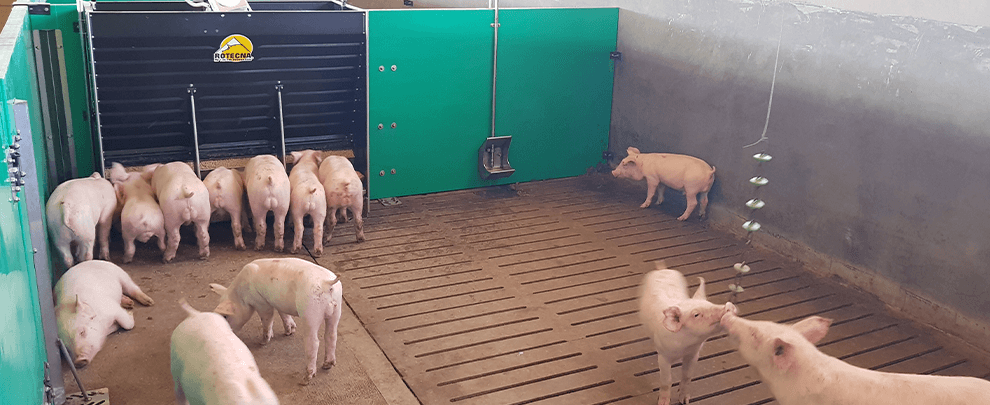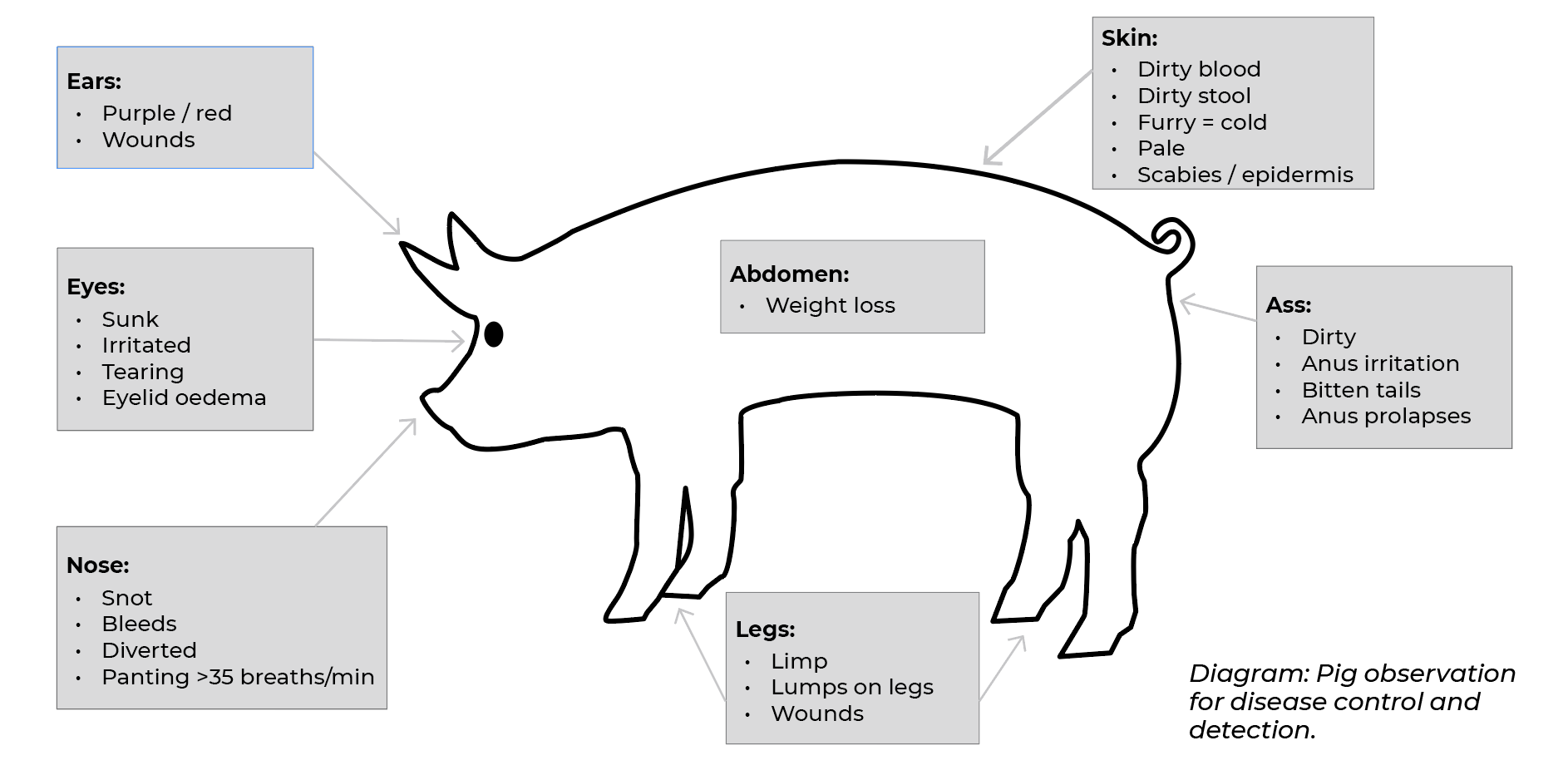Blog
Blog

Tips and recommendations for handling fattening pigs
25th June 2020 - Studies
Josep Rius. Rotecna R+D Department.
Being a good caretaker of fattening pigs implies having specific qualities that are not always easy to meet. The first requirement that must be met is to love animals. It seems obvious, but it is not always true. Others, no less important, are:
- Be responsible and proactive to fulfil the task of overseeing the health of the animals' you manage and guarantee an active intervention, control and decision making, predicting issues.
- Be disciplined, rigorous, constant, and perseverant in following and following established work guidelines.
- Be clean and tidy to keep the workspace in the best conditions and always have everything you need well located.
- Be handy and able to carry out a certainly diverse type of maintenance tasks: knowledge of assemblies of various kinds, plumbing, welding, masonry, electricity, etc.
- Be observant, sensitive, and compassionate, knowing how to see and interpret what animals express, able to put yourself in their place, show mercy when they are suffering and, finally, act accordingly.
A caretaker is primarily responsible for ensuring the health and well-being of the animals that are housed on his farm. Therefore, you must make the following commitments:
- Comply with and enforce compliance with both internal and external biosecurity protocols.
- Ensure that animals always have feed and water in the best conditions.
- Meet your animal welfare needs.
- Ensure reasonable environmental control throughout the fattening process.
- Continuously get zootechnical knowledge to prevent any diseases and, if necessary, alert veterinary technical services as quickly as possible.
To fulfil these duties, caregivers must be familiar with the necessary procedures to guarantee their execution and supervision. In areas such as:
Biosecurity
The location, facilities and equipment determine the specific means that each farm has available to apply biosecurity measures. However, caretakers must be very well informed - whether the animals they care for are their own or those of others - to be the first agents to implement all possible preventive measures to protect them.
- In external biosecurity (avoid the entry of diseases): Supervision of any foreign element that penetrates inside the fenced perimeter of the farm, be it people, vehicles, animals and especially rodents.
- In internal biosecurity (avoid the spread of diseases inside the farm): The cleaning and disinfection of everything that is in direct contact with animals: water sanitation, silos, pen surfaces, water pipes, equipment medication, footwear, clothing, needles, separation boards, and other materials. Delimitation of clean and dirty areas through physical barriers or posters, management of dead animals, placement of footbaths, etc.
Feeding
There are different feeding systems on the market. Regardless of which one is used, the goal is always the same: to satisfy the feeding needs of the animals with the minimum feed waste. Keepers should check the feeding systems daily and ensure that the animals have adequate access to water and feed. This includes both the correct regulation of the dispensing mechanisms and ensuring that they never lack food.
Environmental control
Maintaining environmental conditions inside the fattening houses is essential to optimising the performance of the pigs. Adequate temperature, humidity and air quality stimulate consumption, prevent the appearance of diseases, and prevent animals from using part of the properties provided by food to thermoregulate.
Care
This would include all the tasks aimed at preventing, diagnosing, curing animal diseases, and guaranteeing their welfare. This includes daily observation of the animals, application of pharmacological treatments, housing and pen density planning, cleaning, transfer to the infirmary, etc.
Maintenance
Cleanliness and order both outside and inside the warehouses. Upkeep in perfect working condition of all the elements or mechanisms that are in contact with the pigs: silos and feed transport lines, purification and water transfer equipment, medications, ventilation, heating, windows and aviaries, pest control, corpse container, etc.

WORK ROUTINE
Daily routines help us to better plan our work, save time and be more efficient in its accomplishment, besides increasing our sense of control and understanding over what we are doing. On the contrary, disorganisation generates chaos and causes unexpected or unforeseen situations, with the resulting added effort that must be made to solve it. To become habits, it is necessary to use will power and self-determination. Once you have consciously gotten the habits, its benefits provide security, and in turn, the required strength and encouragement needed to reach new challenges or levels.
In the everyday job of a fattening pig keeper, both physical and mental tasks must be performed. To not forget and guarantee that they are met, it is instrumental to set up a routine control of all the tasks to be carried out during a day, a week or between cycles.
As an example (without considering the specifics of each farm), a management protocol with hopper feeding can be as follows:
Daily routines
- Implementation of the established protocols between the dirty and clean areas when entering the farm.
- First environmental control: reading measurement sensors or controllers (in the case of temperature, it is necessary to have a maximum and minimum level thermometer to contrast the information) and, if necessary, actions to rectify it. Record all readings in daily records.
- Control and annotation of water consumption in the daily records.
- Review the hoppers and drinkers: the amount of feed inside the hopper. Perform assessment and adjustments to ensure water flow and adequate food plate coverage.
- Individual supervision of each of the pigs (make them get up to check that they can walk correctly). For this, it is necessary to take the tools and a separation board to mark them. Take note of the treated animals for their control and traceability.
- Opening of feed transport lines (never leave the farm without certifying that all the bins are full, and the system is stopped).
- Transfer of sick animals to the infirmaries. Give special attention to the animals that are in them.
- Transfer to the corpse container in case of loss.
- Perform maintenance or cleaning tasks.
- Review the state of the research and handling material available for the animals.
- Environmental controls: as many as necessary will be carried out throughout the day.
Weekly routines:
- Analyse trends or patterns registered during the water, feed, climate controls or animal health monitoring, among others.
- Plan the farm supplies planning.
- Review or control visitor registration, individual or general pharmacological treatments.
- Testing of all emergency or alarm devices used on the farm.
- Communication with technical veterinary services.
- Cleaning and maintenance tasks.
- Control of the state of the slurry pits and ponds.
- Control, registration, and management of biocides used on the farm.
- Corpse removal management.
Routines between cycles:
- All the cleaning, disinfection, and maintenance of the interior of the warehouses, medication equipment, water pipes, silos, feed transport, ventilation, or heating equipment, as well as offices, changing rooms, showers, toilets, etc. will be carried out.
- Analysis.
- Management of administrative procedures.
- Emptying of pits and control of the slurry raft.
- Cleaning and maintenance of the exterior of the warehouses.
This is just one example of how to structure a management manual for the different tasks to be performed on a pig fattening farm. Each farm has various facilities and equipment. However, the goals of a caretaker are the same: to preserve the animals' health and well-being and to feed them efficiently. To achieve this, it is helpful to have written work routines, because they help - not only the caregiver but the entire technical team responsible - to set a standard course. However, it is a tool that will not develop its full potential or utility if it is not accompanied by continuous training, which will allow caregivers to get the necessary knowledge to assimilate the positive aspects of its application.
Caring for fattening pigs is an unknown profession for most people disconnected from the agricultural or livestock sector, which is often associated with low-skilled occupations. As it has been verified, it is a belief far removed from reality. A good of fattening pigs caretaker performs a complete job for which it is necessary to have knowledge and skills in different areas in their day to day.






